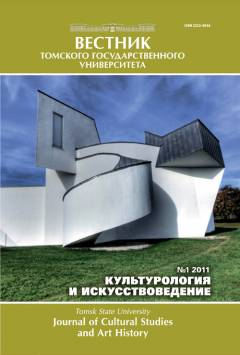The intertext as a method of forming in design
The intertext and the game - actual methods of forming objects of postmodern art and design. With their help, in the form philosophical, cultural, social, composite, plastic ideas and meanings are realized. In the era of excessive the consumer society changed understanding of the functionality: the “fun” of an object can be perceived as its functional characteristics. This fact testifies not “frivolous” attitude to the shaping, but rather speaks to the “maturity” of the perception of task design: culture, according to Johan Huizinga, is born from the game and has a game character and an object of design through play creates culture. The intertext as a method of forming allows modern design to detect the connection of its objects with history, cultural tradition, atmosphere, environment, creating, thus, the playing field for the consumer. Intertextuality as a generic property of culture correlates with the modern concepts of creativity and the processes of forming in design. The so-called “historical” creativity enhance the ability of the creative person to operate the achievements of culture, cultural ideas and concepts, told through chronotopical dimension and embodied in combinatorial (form, based on an unusual reading or incarnation of already known ideas), research (form projected in the process of research, discovery and articulation of the problems of the user, customer) and innovation (completely new, previously embodied form) approaches to forming. Between poetry and any other artistic work, including, design there is a direct analogy. As in poetry, in the process of working on a form of poetic speech is the introduction of additional measures not defined by the needs of ordinary language, but enhancing the emotional and aesthetic qualities of the verse, and in the process of design, creation of visual forms there is an additional measure that emphasizes or enhances the inherent designer's conceptual idea of the design. Designer, designing some form, put it in certain ideas and meanings. The consumer is in the process of form perception decodes the meanings designer, and conscious, and unconscious. It is possible to allocate four basic options of building form on the basis of intertextuality: direct quote; “retelling”; the interpretation and reinterpretation of texts of culture background; links to ideas, concepts, images. In the process of forming intertexts perform the following main functions: 1. information; 2. text forming - the intertext forms a substantial basis of the new form; 3. Illustration - the intertext illustrates the concept of forming; 4. actualization - intertext broadcasts the relevance, value, importance of inherent meaning in a specific context, or conceptual space.
Keywords
game, design, methods of forming, intertext, игра, дизайн, методы формообразования, интертекстAuthors
| Name | Organization | |
| Pendikova Irina G. | Omsk State Technical University | megavia@mail.ru |
References

The intertext as a method of forming in design | Tomsk State University Journal of Cultural Studies and Art History. 2019. № 34. DOI: 10.17223/22220836/34/12